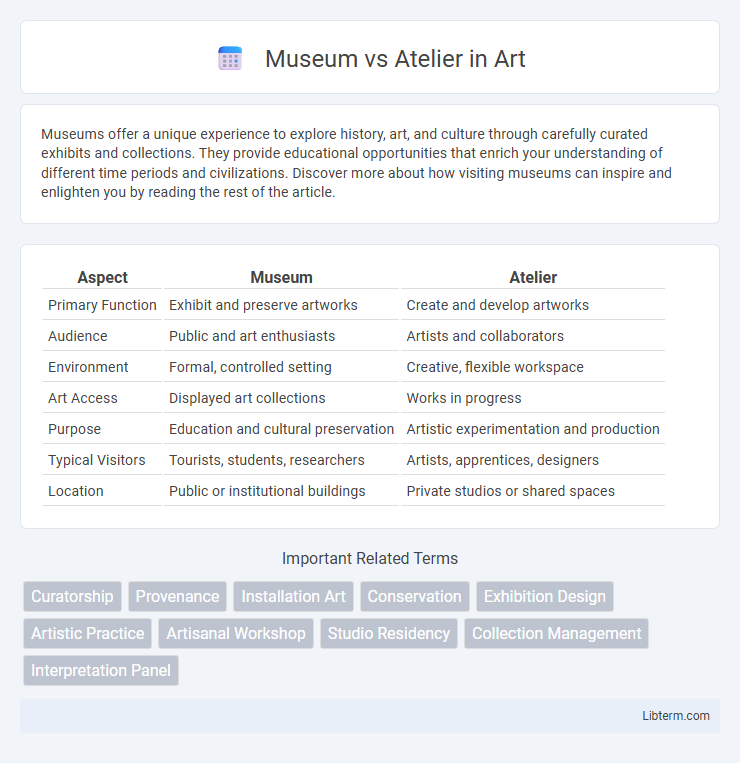Museums offer a unique experience to explore history, art, and culture through carefully curated exhibits and collections. They provide educational opportunities that enrich your understanding of different time periods and civilizations. Discover more about how visiting museums can inspire and enlighten you by reading the rest of the article.
Table of Comparison
| Aspect | Museum | Atelier |
|---|---|---|
| Primary Function | Exhibit and preserve artworks | Create and develop artworks |
| Audience | Public and art enthusiasts | Artists and collaborators |
| Environment | Formal, controlled setting | Creative, flexible workspace |
| Art Access | Displayed art collections | Works in progress |
| Purpose | Education and cultural preservation | Artistic experimentation and production |
| Typical Visitors | Tourists, students, researchers | Artists, apprentices, designers |
| Location | Public or institutional buildings | Private studios or shared spaces |
Introduction to Museums and Ateliers
Museums serve as curated spaces dedicated to preserving, exhibiting, and educating the public about art, history, and culture through carefully managed collections. Ateliers function as creative workshops where artists actively produce and refine their work, emphasizing hands-on techniques and personalized artistic expression. Both institutions contribute uniquely to the art ecosystem: museums prioritize conservation and public engagement, while ateliers foster innovation and creative development.
Defining the Museum Experience
The museum experience centers on curated collections displayed within controlled environments, emphasizing historical context, education, and preservation of artifacts. Museums offer structured narratives through exhibitions, guided tours, and interpretive materials to engage visitors intellectually and emotionally. Unlike ateliers, which focus on active creation and artistic processes, museums prioritize observation, reflection, and cultural enrichment.
What is an Atelier?
An atelier is a creative workspace where artists, designers, or craftsmen actively produce and experiment with their work, emphasizing hands-on creation and innovation. Unlike museums, which primarily serve as exhibition spaces for finished art pieces and historical artifacts, ateliers foster the artistic process and skill development in real time. This environment encourages collaboration, mentorship, and direct engagement with materials, making it integral to artistic growth and craftsmanship.
History and Evolution of Museums
Museums originated in ancient civilizations as sacred spaces for preserving artifacts and showcasing cultural heritage, evolving through the Renaissance into public institutions dedicated to education and preservation. The 18th and 19th centuries marked significant growth with the establishment of national museums, reflecting Enlightenment ideals and advancing the professionalization of curation and conservation methodologies. Unlike ateliers, which focus on artistic creation and craftsmanship, museums have continuously adapted to technological innovations and interdisciplinary approaches to enhance historical interpretation and audience engagement.
The Legacy of Traditional Ateliers
Traditional ateliers preserve centuries-old artistic techniques through hands-on mentorship and personalized craftsmanship, fostering a unique legacy in art creation. Unlike museums, which primarily focus on the display and preservation of finished artworks, ateliers emphasize the transmission of skills and the creative process itself. This living tradition ensures that artisanal methods and tactile knowledge continue to thrive alongside contemporary art practices.
Key Differences: Museum vs Atelier
A museum primarily serves as a public institution that collects, preserves, and exhibits artworks and historical artifacts for educational and cultural enrichment. An atelier functions as a private or collaborative artist's workspace where creation, experimentation, and hands-on artistic production occur. The museum emphasizes curation and presentation to the public, whereas the atelier centers on the creative process and skill development within an intimate setting.
Visitor Engagement and Interaction
Museums offer structured exhibits with informative displays designed to educate and inspire visitors through curated collections and guided tours, enhancing passive learning experiences. Ateliers encourage active participation by allowing visitors to engage in creative processes, hands-on workshops, and direct interactions with artists, fostering immersive and personalized experiences. Visitor engagement in museums centers on observation and reflection, whereas ateliers emphasize collaboration, creativity, and real-time skill development.
Impact on Art Preservation and Creation
Museums play a critical role in art preservation by providing controlled environments that protect artworks from deterioration, ensuring their longevity for future generations. Ateliers prioritize art creation through hands-on instruction and experimentation, fostering innovation and the development of new artistic techniques. Both institutions collectively sustain the cultural ecosystem by balancing conservation with creative evolution.
Educational Opportunities in Both Spaces
Museums offer curated educational programs that provide historical context and expert interpretations through guided tours, workshops, and interactive exhibits, enhancing visitor understanding of art and culture. Ateliers focus on hands-on learning experiences where students engage in practical creative processes, developing skills under the mentorship of experienced artists. Both spaces complement each other by combining theoretical knowledge with practical application, fostering comprehensive art education.
Choosing the Right Space for Artists and Audiences
Selecting between a museum and an atelier hinges on the intended experience for both artists and audiences; museums offer curated exhibits that emphasize art preservation and public education, while ateliers provide immersive, hands-on environments fostering creativity and direct artist engagement. Museums attract diverse audiences seeking historical context and artistic narratives, whereas ateliers appeal to those desiring interactive participation and insight into the artistic process. Prioritizing user engagement and the nature of art presentation guides the choice of space to maximize impact and artistic value.
Museum Infographic

 libterm.com
libterm.com